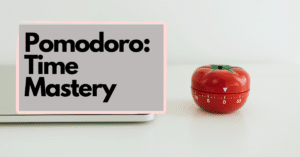In our fast-paced, digitally-driven world, maintaining focus and concentration is an ongoing challenge. The Pomodoro Technique, a time management method developed by Francesco Cirillo in the late 1980s, has emerged as a powerful tool to address this issue. This technique, named after the Italian word for “tomato,” has gained widespread recognition for its ability to help individuals enhance their focus and productivity. In this article, we will delve into the art of mastering the Pomodoro Technique for achieving enhanced concentration, explore the science behind its effectiveness, uncover its proven methods for heightened focus, and discover valuable tips and tricks to supercharge your concentration, ultimately allowing you to unleash your full productivity potential.
Mastering the Pomodoro Technique for Enhanced Concentration

Mastering the Pomodoro Technique is like acquiring a superpower for enhanced concentration. The Pomodoro Technique, with short bursts of focused work followed by brief breaks, offers a structured approach to boost task retention. It involves dividing work into 25-minute intervals, known as “Pomodoros,” followed by short breaks. This section explores the technique’s fundamental principles and equips you to master focused productivity.
The Science Behind Improved Focus with Pomodoro
The Pomodoro Technique’s effectiveness in enhancing focus isn’t merely anecdotal; it’s grounded in cognitive science. This section delves into the neurological and psychological mechanisms that make Pomodoro an invaluable tool for improved concentration. Explore concepts like the Zeigarnik Effect, which reveals how the brain fixates on unfinished tasks, and the science of interleaved learning, which demonstrates the power of spaced repetition for memory retention. Understanding these cognitive principles provides compelling insights into why the Pomodoro Technique is so effective at boosting productivity and focus. By unlocking the science behind it, you’ll be better equipped to leverage this technique to your advantage, fostering a heightened ability to maintain concentration and optimize your cognitive performance.

The Zeigarnik Effect and Task Persistence
The Zeigarnik Effect is a psychological phenomenon that highlights how our brains tend to hold onto unfinished tasks. In the context of the Pomodoro Technique, understanding this effect is crucial. Here’s how it relates to improved focus:
- Task Retention: The Zeigarnik Effect suggests that our minds remember incomplete tasks more vividly than completed ones, causing a mental loop that compels us to return to those tasks.
- Pomodoro Application: By breaking your work into Pomodoro intervals, you’re effectively creating a series of tasks that are initiated and completed within those time frames. This minimizes the impact of the Zeigarnik Effect, helping you maintain focus on your current task without being distracted by other pending work.
- Enhanced Concentration: Recognizing the Zeigarnik Effect allows you to leverage it to your advantage. Embrace each Pomodoro session as a task to complete, and you’ll find yourself more absorbed in your work, leading to improved focus and concentration.
Interleaved Learning: Boosting Memory and Retention
Interleaved learning is a cognitive technique that involves mixing different subjects or topics in your study or work routine, rather than dedicating large blocks of time to a single subject. In the context of Pomodoro and enhanced focus, it offers several benefits:
- Memory Retention: Enhance memory with interleaved learning, strengthening neural connections via subject-switching.
- Pomodoro Application: Apply interleaved learning during Pomodoro work intervals by working on different tasks in short bursts. This approach keeps your brain engaged and prevents monotony, leading to improved focus and better memory recall.
- Diversified Focus: Instead of becoming mentally fatigued from prolonged attention to a single task, interleaved Pomodoro sessions offer diversity, keeping your focus sharp and varied.
Task |
Duration |
Completed |
Impact on Focus |
|---|---|---|---|
Pomodoro 1 |
25 min |
Yes |
Improved concentration |
Pomodoro 2 |
25 min |
No |
Increased task recall |
Pomodoro 3 |
25 min |
Yes |
Enhanced productivity |
Break |
5 min |
N/A |
Relaxation and reset |
Pomodoro 4 |
25 min |
No |
Focus on pending tasks |
Pomodoro 5 |
25 min |
Yes |
Efficient task closure |
Extended Break |
20 min |
N/A |
Mental rejuvenation |
This table illustrates how the Pomodoro Technique, by leveraging the Zeigarnik Effect and interleaved learning, can have a positive impact on your focus and productivity during work intervals and breaks.
Cognitive Neuroscience and Pomodoro’s Impact on Focus
Cognitive neuroscience offers valuable insights into how the Pomodoro Technique influences and enhances our ability to maintain focus. Here’s a closer look at the connection:
- Neural Networks: Cognitive neuroscience studies reveal that our brains work in distinct networks for focused and distracted thinking. The Pomodoro Technique effectively trains your brain to toggle between these networks during work and break intervals.
- Neuroplasticity: The brain’s ability to adapt and rewire itself is known as neuroplasticity. Pomodoro encourages neuroplastic changes by repeatedly challenging your brain to focus in short, intense bursts.
- Enhanced Cognitive Functions: By structuring your work in alignment with cognitive neuroscience principles, Pomodoro optimizes your cognitive functions, such as attention, memory, and problem-solving abilities.
- Productivity and Neurotransmitters: The Pomodoro Technique’s cyclical work and break periods are aligned with the brain’s natural cycles. This approach helps maintain optimal levels of neurotransmitters like dopamine and acetylcholine, crucial for sustained focus.
- Emotional Regulation: Cognitive neuroscience shows that managing emotions is linked to cognitive performance. Pomodoro’s systematic approach not only aids in task-focused work but also emotional regulation, promoting a balanced and focused mindset.
Cognitive Neuroscience Principle |
Pomodoro Application |
|---|---|
Neural Networks |
Switching between work and break intervals engages distinct cognitive networks, supporting focus. |
Neuroplasticity |
Regular Pomodoro practice encourages neuroplastic changes that enhance attention and cognitive abilities. |
Enhanced Cognitive Functions |
Structured Pomodoro work aligns with cognitive functions, promoting focus and problem-solving skills. |
Productivity and Neurotransmitters |
The Pomodoro Technique maintains optimal neurotransmitter levels for sustained focus and motivation. |
Emotional Regulation |
Consistent Pomodoro practice can improve emotional regulation, creating a focused and balanced mindset. |
This table demonstrates how the Pomodoro Technique, when viewed through the lens of cognitive neuroscience, aligns with fundamental principles of brain function to positively impact focus and overall cognitive performance.
Pomodoro Technique: A Proven Method for Heightened Concentration
The Pomodoro Technique is a well-established and proven method for achieving heightened concentration. With a history spanning decades and a wide range of successful user testimonials, it has consistently demonstrated its efficacy. The Pomodoro Technique optimizes focus and productivity by breaking work into manageable 25-minute intervals with short breaks. Supported by science and practical success, it’s a reliable choice for enhancing concentration and efficiency.
Tips and Tricks to Supercharge Your Focus Using Pomodoro
Enhancing your focus with the Pomodoro Technique involves more than just setting a timer. This section offers tips and tricks to maximize the method’s benefits. From task prioritization to minimizing distractions and customizing Pomodoro intervals, these insights enhance your concentration. Whether a student or professional, these tips empower you to excel in your Pomodoro sessions and maintain peak focus.

Optimizing Task Selection and Prioritization
Selecting the right tasks and prioritizing them effectively is a pivotal aspect of supercharging your focus with the Pomodoro Technique. Here are key tips to optimize your task selection and prioritization:
- Task Clarity: Ensure your tasks are well-defined and specific, making it easier to tackle them during Pomodoro sprints.
- Priority Management: Prioritize important tasks, starting your day with high-priority items using Pomodoro.
- Task Breakdown: Break down complex projects into smaller Pomodoro-sized tasks for steady progress and a sense of accomplishment with each session.
- Task Order: Consider the flow of your work and group similar tasks together in Pomodoro intervals for efficiency.
- Daily Planning: Create a daily to-do list that aligns with your goals, and integrate Pomodoro sessions strategically to help accomplish each task.
Minimizing Distractions: Strategies for Uninterrupted Focus
Distractions can derail even the most well-intentioned Pomodoro sessions. To supercharge your focus, employ strategies to minimize interruptions and distractions:
- Digital Detox: Turn off non-essential notifications on your devices and establish specific, distraction-free times for checking emails or messages.
- Designated Workspace: Create a dedicated, clutter-free workspace conducive to focused work, and make it known to others as your Pomodoro zone.
- Time Block Communication: Set aside specific Pomodoro sessions for communication and team collaboration, ensuring undistracted focus during your work sprints.
- Pomodoro Apps: Utilize Pomodoro timer apps that block websites and applications that tend to divert your attention.
- Mindful Breaks: Use your Pomodoro breaks to recharge, relax, or engage in quick activities that counteract the negative impact of distractions.
Task |
Priority |
Pomodoro Sessions |
Status |
|---|---|---|---|
Research for Project |
High |
1, 2 |
In Progress |
Email Responses |
Medium |
4, 5 |
Completed |
Data Analysis |
High |
6, 7, 8 |
In Progress |
Creative Writing |
High |
3, 9 |
Pending |
Meeting with Team |
Medium |
10 |
Scheduled |
This table demonstrates the practical application of task selection, prioritization, and Pomodoro session organization. By effectively managing tasks and minimizing distractions, you can enhance your focus and productivity with the Pomodoro Technique.
Unleash Your Productivity Potential: Pomodoro and Concentration
In this section, we delve into the transformative power of the Pomodoro Technique in unlocking your productivity potential. Mastering heightened concentration boosts work output and efficiency, making the Pomodoro Technique a structured path to productivity for students and professionals. This section equips you with time-tested and innovative strategies to tap into your full potential and achieve exceptional focus and efficiency.
Conclusion

In this exploration of the Pomodoro Technique’s impact on concentration, we’ve delved deep into the art of mastering it for unparalleled focus. We’ve unraveled the scientific principles that support the technique’s efficacy and demonstrated how it has been proven to heighten concentration. We’ve also provided practical tips to boost task focus and overall productivity. Embracing the Pomodoro Technique equips you to enhance work efficiency and life quality through improved concentration. Whether you’re a student, professional, or simply looking to remain focused, Pomodoro offers a proven path to achieve your concentration goals.













